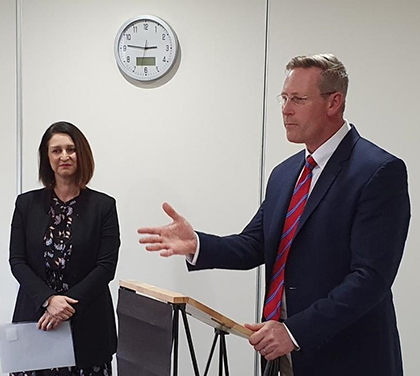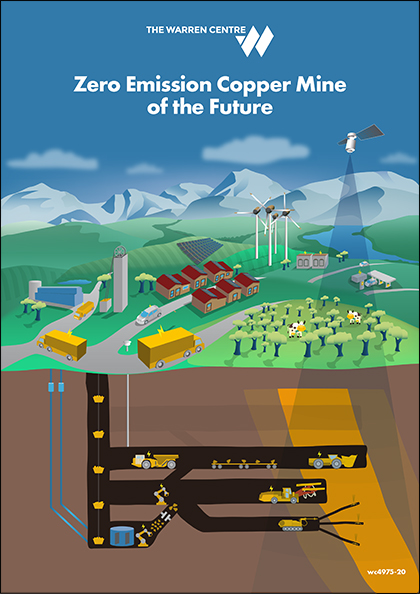Launch pad for world-first projects.
Innovation, sustainability and world-first projects directed at discovering more copper and boosting emerging supply chains headlined June’s Copper to the World Online, hosted by the Department for Energy and Mining.
More than 280 people from across the globe logged on to hear about new initiatives to grow copper supply, the macro forces shaping copper markets, the rising trend for responsible mining and the work towards a zero emission mine for the future.
Minister for Energy and Mining, The Hon Dan van Holst Pellekaan, set an upbeat tone, recognising the outstanding efforts of South Australian copper producers through the pandemic in looking after people while taking up technology to sustain copper supplies.
‘Industry and government worked together during the pandemic enabling South Australia to emerge as a safe and secure haven to live, work and to importantly invest’, he said.
‘Our sector really stood out. It was a tremendous example of organisations in collaborative supply chains doing better than ever and organisations that are normally competitive coming together for the common good’.
Core Innovation Hub
Minister van Holst Pellekaan announced world-first projects to help grow South Australia’s mineral sector and attract international partners in line with the push to become one of the most sustainable, technologically advanced energy and mining regions.
The South Australian government has forged a public–private foundation partnership with the Core Innovation Hub, supported via the government’s Economic and Business Growth Fund.
Headquartered at the Stone & Chalk start-up hub at Lot Fourteen, in Adelaide’s CBD, with a satellite in the Tonsley Innovation District, Core will encourage the flow of ideas between people immersed in machine learning, space, integrated solutions, cybersecurity, defence, automation, software, advanced manufacturing and the resource and energy sectors.
‘Deep alliances with complementary industries can build productive, safe operations and vibrant equipment and technology supply chains’, Minister van Holst Pellekaan said.
The hub’s state manager, Renee Hakendorf, outlined exciting plans to drive the next wave of productivity growth.
‘Our goal is to foster an environment where innovation thrives and where innovators are actively supported to develop the technologies of tomorrow’, Renee said.
‘Together we will build an engaged community along the value chain’, she added as she released a dynamic innovation ecosystem map of organisations and capability and invited organisations and people to sign on.
‘The digital age is here and we want to help industry take up this opportunity … to build the capability, the community and capacity to be able to take their businesses forward and solve industry’s challenges for the future’.
The hub will also provide valuable skill pathways and training packages to equip all tiers of the workforce in the skills and thinking in data science capability aligned to machine learning.

Minister for Energy and Mining, the Hon Dan van Holst Pellekaan, and the South Australian State Manager of the Core Innovation Hub, Renee Hakendorf, address Copper to the World Online.
Dynamic tools
Minister van Holst Pellekaan also announced the first round of successful applicants for the Accelerated Discovery Initiative totalling $2.9 million, many of the projects pushing the boundaries of conventional exploration to drive exploration dollars further (see separate story).
‘We are doing everything we can to drive every exploration dollar further’, Minister van Holst Pellekaan said referring to the dynamic tools explorers are taking up.
Meanwhile with the boom in machine learning, South Australia’s global crowdsourcing competition, Explore SA: The Gawler Challenge, has attracted over 2,000 global innovators. Winners of the first phase of the competition, the Data Prep Prize, were announced on 2 June 2020 (see separate story).
‘Desktop research is perfect for these COVID times’, he said.
 Zero emission mine of the future
Zero emission mine of the future
Another first was the world launch of The Warren Centre’s new research paper, a technology roadmap of the Zero emission copper mine of the future.
The roadmap, commissioned by the International Copper Association Australia, lays out how copper mining and refining can achieve carbon neutrality over the next 30 years. The report looked at all aspects of the copper development chain for emission intensity, requiring technical innovation over the short- to long-term horizon.
Achieving cutting-edge innovation will depend on these collaborative levers: policy and programs, industry networks, capital enablers, future knowledge and an open mindset.
To take a major leap forward to how energy is consumed, sourced and abated, Ashley Brinson, Executive Director of The Warren Centre, called for aspirational thinking of the kind that propelled humankind into space.
‘We need a shared vision for the long range, and moonshot thinking can change the perception that challenges are too hard to confront, or that facing them alone or as individuals is impossible’.
Responsible production hits the mark
Craig Lang, Principal Analyst CRU Group, walked delegates through the copper metal markets, noting the quick recovery of copper prices from a sharp pandemic-induced dip and the interplay between COVID-19 on both demand and supply movements, panning out to a steady-state outlook for mid term. Mining project developments are likely to be constrained in the next couple of years.
Executive Director Michèle Brülhart gave a comprehensive progress report on The Copper Mark, an assurance system to demonstrate leading practice to meet enhanced trading exchange, investor and customer expectations for sound environmental and social governance.
‘The rising trend to source metals responsibly is coming from investors, as well as non-government organisations and the London Metals Exchange has issued a new policy on responsible sourcing’, Michèle said.
‘We are seeing a lot of interest in copper being used in transition to green economy – and [for people] to know that copper has been produced in a clean and green fashion’.
The Copper Mark is a response to those drivers and to the United Nations’ sustainable development goals for responsible consumption and production. The system addresses 32 environmental, social and governance issues connected to responsible production of copper. Rather than creating new standards, Michèle said, The Copper Mark has adopted leading certifications that meet their criteria – using the Responsible Minerals Initiative’s Risk Readiness Assessment. This made sense as copper often occurs and is extracted alongside other metals.
The Copper Mark’s governance model includes a high-powered advisory council comprising diverse voices. The assurance mechanism involves independent verification and includes site assessments that encourage continual improvement.
Recent developments
Coinciding with the conference, copper explorers and miners released discoveries and developments in South Australia. Copper to The World Online moderator, the department’s Executive Director Mineral Resources, Alex Blood, flagged OZ Mineral’s approval to move to prefeasibility for the Carrapateena block cave expansion, and Western Areas’ impressive strike of nickel and copper sulfides at their Sahara project in the western Gawler Craton.
‘The Geological Survey of South Australia will also be undertaking a new geoscience program with CSIRO exploring for sedimentary-hosted copper assets in the Stuart Shelf that offers the opportunity to find mass deposits’, Alex said.
– Grace Taylor, July 2020


